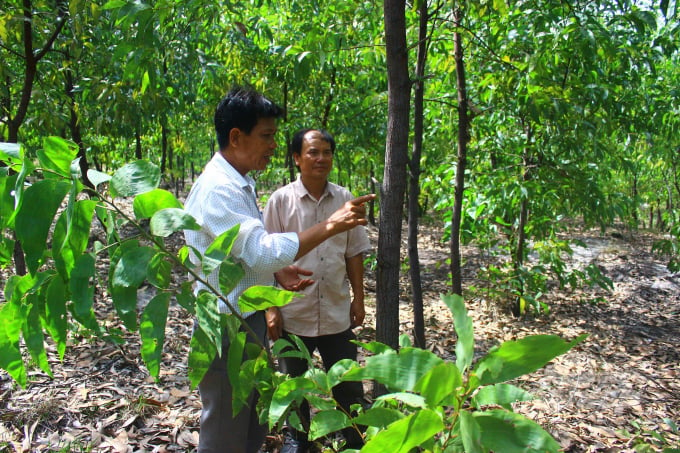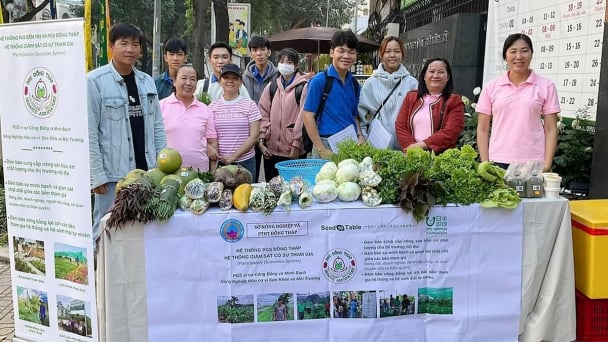May 22, 2025 | 12:26 GMT +7
May 22, 2025 | 12:26 GMT +7
Hotline: 0913.378.918
May 22, 2025 | 12:26 GMT +7
Hotline: 0913.378.918
Much land along the coastal area of Hai Lang District in Quang Tri Province has been deserted for years due to sand-related problems. However, the recent policies of land and forest allocation, along with the encouragement of forest economic development, have given this area a facelift.
In less than 5 years, northern wattle forest planted on nearly 15 hectares on the sandy land of Dong Duong Cooperative, Hai Duong Commune in Hai Lang District has proved its effectiveness.
According to the deputy director of the cooperative, Tran Xuan Hoanh, this area of planted forest, along with that of the natural forest, has helped to block the wind, preventing flying sand and preserving moisture for various crops.
Thanks to the shelter provided by the forest planted on the sand, locals now can cultivate many kinds of crops, particularly bitter gourd or the cucumber.

Afforestation on sand helps to prevent sand-related problems. Photo: Cong Dien.
To minimize the problem of flying sand, the local authority has encouraged afforestation on sand since the 2000s. By now, most of the uncultivated sandy area of the cooperative has been covered with forests of melaleuca, casuarina and northern wattle, he said.
"In the coming time, we will continue to advocate and support people to expand the area of melaleuca forest to make the most of the sandy area, helping locals increase their income and improve their lives," Hoanh confirmed.
Hai Que Commune is the locality in Hai Lang District with a fairly large area of forest on the sand - nearly 300 hectares. Hoang Tan Thong, Chairman of Hai Que Commune People's Committee, said that the locality has mobilized locals to plant forests on uncultivated sandy areas in responding to the Government's 661 afforestation program
These forest areas have created a windbreak belt that has significantly alleviated the sand-related problems and preserved the humidity so that villagers could cultivate 150 hectares of all kinds of crops on the sandy area every year.
“Many households have become well off thanks to afforestation on the sand and the cultivation of various crops. The forest area on the sand has also become a shield to protect villages from the devastation of natural disasters,” he said.
It is estimated that the whole Hai Lang District has about 850 hectares of forest on the sand, mainly in the communes of Hai Ba, Hai Duong, Hai Que, Hai An and Hai Khe. In which, there are many hundred-year-old natural forests that are being protected and remain almost intact.
The authority of Hai Lang District has issued a policy of allocating land and forest to households and communities for management.
In addition to conventions on forest protection of each locality and each residential area, the protection of forests on sand in Hai Lang District has been properly implemented, which has therefore created a shelter to block wind, prevent flying sand and saltwater intrusion while preserving moisture for the production of crops cultivated on the sand.
According to Deputy Head of the Hai Lang District Forest Protection Department, Van Loi, besides the economic benefits, the forest system on the sand has minimized the effects of climate change and natural disasters; prevented erosion and landslides in addition to regulating water sources.
“In recent years, coastal communes such as Hai An and Hai Khe have faced the problem of underground sea water infiltration. Some wells are unusable because of saline intrusion and the rate of groundwater salinization is getting deeper and deeper inland,” he said.

Together with economic efficiency, afforestation on sand has minimized effects of climate change. Photo: Cong Dien.
That means fresh water resources have been exhausted so salt water has penetrated underground, posing a great risk to chemical and physical changes in coastal sandy areas. Therefore, planting forests on sand will help the surface fresh water to be retained by the root system that prevents surface runoff and to gradually seep into the ground. In the long run, it is possible to limit the ongoing saline intrusion in the area.
Vice Chairman of Hai Lang Duong District People's Committee, Duong Viet Hai, affirmed that the afforestation on sand has helped stabilize the sand area and production land; actively contributed to the redistribution of population and settlement for residents in coastal sandy areas.
Thereby, many new economic models have been launched and agro-forestry farms have been set up on sandy areas, creating jobs for local laborers and therefore actively contributing to poverty alleviation and new rural construction of the locality.
However, according to the assessment, the forest cover on sand is still low compared to the overall coverage of the district. Meanwhile, the forests do not have diversified types of trees as they are planted mainly with acacia, casuarina, and melaleuca. The work of allocation, lease and contract of forest and forestry land is still slow compared to the requirement and could not create a concentrated raw material area to stably meet market demand.
In addition, overlapping in forest planning still exists. The awareness of forest management, protection and development of a small part of the population is still low, so the encroachment of forest land for agricultural and fishery production still occurs.
To stabilize the forest area in the sandy area, Hai Lang District’s authorities have issued many policies to support the planting of scattered trees to create shade and increase protection in the whole region, while launching campaigns to raise awareness for the population.
Simultaneously, sustainable livelihood models on sandy areas such as afforestation for livelihood and agro-forestry production have been deployed and replicated, while the establishment of forestry production and business groups such as afforestation clubs or forest product processing clubs has been encouraged with the aim to exchange experiences and expand production scale.
Translated by Phuong Ha
![Reducing emissions from rice fields: [2] Farmers’ commitment to the soil](https://t.ex-cdn.com/nongnghiepmoitruong.vn/608w/files/news/2025/05/05/dsc08881jpg-nongnghiep-140632.jpg)
(VAN) Clean rice cultivation model in Thuong Tan commune, Bac Tan Uyen district, is assisting local residents in achieving sustainable agriculture by substantially reducing costs, increasing productivity, and protecting the environment.

(VAN) At the conference to disseminate Resolution No. 68, AgriS introduced its digital agricultural ecosystem and reaffirmed its commitment to accompanying the Government in promoting private sector development and sustainable agriculture.

(VAN) 'Blue Ocean - Blue Foods' initiative is designed to restore marine ecosystems and establish sustainable livelihoods for local communities by cultivating a minimum of 1,000 hectares of cottonii seaweed in the first three years.
/2025/05/21/4642-3-112707_603.jpg)
(VAN) The V-SCOPE project has made direct contributions to three out of six pillars of the Comprehensive Strategic Partnership between Vietnam and Australia.

(VAN) Facing the threat of rabies spreading to the community, Gia Lai province urgently carries out measures to vaccinate dogs and cats on a large scale.

(VAN) Disease-free livestock farming not only protects livestock herds but also stabilizes production and livelihoods for many farmers in Tuyen Quang.

(VAN) Japan's grant aid project contributes to capacity building, promoting organic agricultural production, and fostering sustainable community development in Dong Thap province.